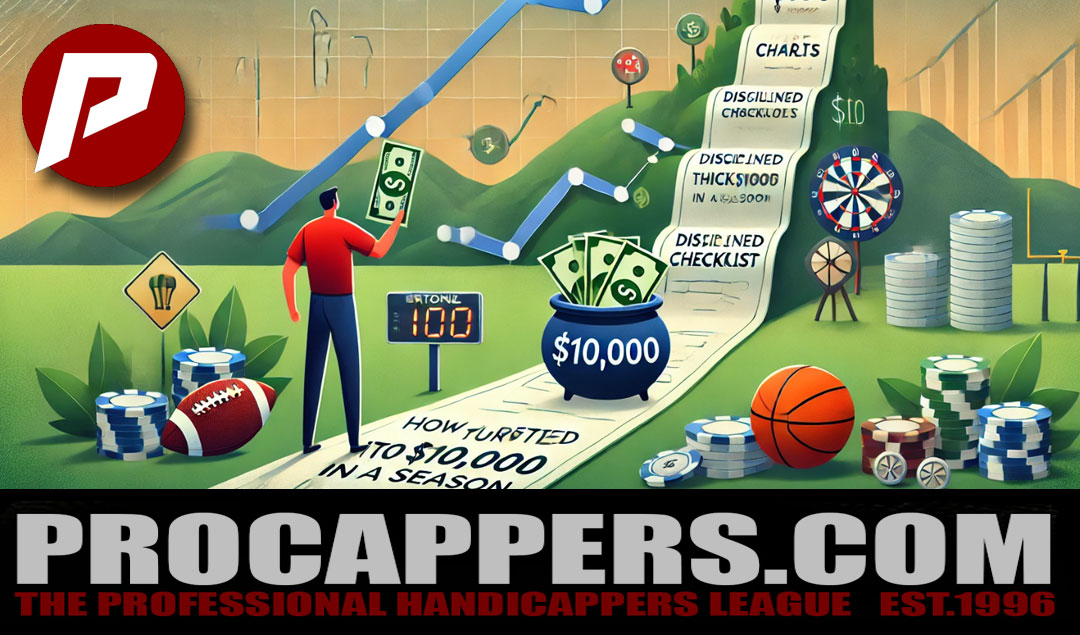
How a Bettor Turned $100 into $10,000 in a Season
Turning a modest $100 bankroll into $10,000 over the course of a sports season might sound like a dream, but it is a feat that has been achieved by disciplined and strategic bettors. This case study examines how one bettor managed to accomplish this remarkable transformation, highlighting the strategies, mindset, and key decisions that made it possible. While such success is not guaranteed, the principles behind it can inspire and guide others looking to improve their own betting game.
Starting with a Plan
The bettor, whom we will call Alex, began the season with $100 and a clear plan:
Set a Goal: Alexs goal was to grow the bankroll steadily over the course of the season, focusing on long-term success rather than quick wins.
Establish a Betting Unit: Alex decided to bet 1% of the initial bankroll ($1) per wager to minimize risk. As the bankroll grew, the unit size was adjusted accordingly.
Focus on Value: Instead of betting on popular teams or high-profile games, Alex concentrated on finding value in the odds?games where the probability of success was higher than the implied odds suggested.
Leveraging Research and Analysis
A key factor in Alexs success was a commitment to research. Before placing any bet, Alex:
Analyzed Statistics: Alex used advanced metrics such as team performance trends, player statistics, and situational factors (e.g., home/away splits).
Tracked Line Movements: By monitoring how betting lines shifted, Alex could identify games where sharp money was influencing odds.
Considered Context: Alex factored in external variables like injuries, weather conditions, and schedule fatigue.
This meticulous approach allowed Alex to identify hidden opportunities that casual bettors often overlooked.
Staying Disciplined
Discipline was a cornerstone of Alexs strategy. Here is how Alex maintained focus:
Avoided Emotional Betting: Alex never bet on favorite teams or made impulsive decisions after a loss.
Stuck to the Unit System: Even during a winning streak, Alex resisted the urge to increase bets recklessly. The unit size only grew when the bankroll increased significantly.
Skipped Risky Parlays: While tempting, parlays were avoided because of their low probability of success.
Key Turning Points
Capitalizing on Underdogs:
One of Alexs most profitable strategies was betting on undervalued underdogs. For example, in Week 5 of the NFL season, Alex placed a $5 bet on a +300 underdog that won, netting $15 in profit. These calculated risks contributed significantly to the bankroll?s growth.Bankroll Milestone Adjustments:
Once Alexs bankroll hit $500, the betting unit increased to $5. This incremental growth allowed for larger bets without overexposing the bankroll.Avoiding Chasing Losses:
During a rough patch mid-season, Alex stuck to the plan rather than chasing losses with larger bets. This patience paid off as a string of well-researched wins followed.
The Results
By the end of the season, Alexs bankroll had grown from $100 to just over $10,000. Here is a breakdown of the key numbers:
Starting Bankroll: $100
Total Bets Placed: Approximately 500
Average Bet Size: Started at $1, ended at $100
Win Rate: 58%
ROI (Return on Investment): 9,900%
Lessons Learned
Alexs journey offers several takeaways for aspiring bettors:
Discipline is Key: Consistent bankroll management and sticking to a plan are essential.
Value Over Popularity: Betting on value rather than popular picks creates better long-term results.
Incremental Growth: Adjusting bet sizes based on the bankroll?s growth allows for compounding gains.
Patience Pays Off: Success in sports betting requires a long-term mindset and the ability to endure ups and downs.
Final Thoughts
Alexs story is a testament to the power of discipline, research, and strategic betting. While not every bettor will replicate this success, adopting these principles can lead to more informed and profitable decisions. Remember, sports betting is not about hitting a big win overnight, it is about making smart, calculated bets that pay off over time.
Articles & Previews
See All
Smart Betting Starts With Sharp Information: Why ProCappers.com Is the Edge Bettors Need
Posted Thursday, December 11, 2025

Why Smart Bettors Trust the Numbers at ProCappers.com
Posted Friday, December 5, 2025

The Ultimate Guide to Betting on College Football Bowl Games
Posted Thursday, December 4, 2025

ProCappers.com | Verified Sports Picks, Expert Handicappers & Winning Insights
Posted Tuesday, December 2, 2025
Hot Handicappers
Yesterday
-
 George Smeader
$10,320
George Smeader
$10,320
-
 BG Sports
$10,250
BG Sports
$10,250
-
 Steve Miller
$8,800
Steve Miller
$8,800
-
 Zhou Wei
$7,820
Zhou Wei
$7,820
-
 Joe Gunn
$7,320
Joe Gunn
$7,320
Last 7 Days
-
 George Smeader
$39,040
George Smeader
$39,040
-
 Zhou Wei
$20,030
Zhou Wei
$20,030
-
 BG Sports
$18,290
BG Sports
$18,290
-
 David Merke
$17,900
David Merke
$17,900
-
 Steve Miller
$17,800
Steve Miller
$17,800
Last 30 Days
-
 Big Mac O'Reilly
$34,180
Big Mac O'Reilly
$34,180
-
 Eduardo Costa Verez
$29,280
Eduardo Costa Verez
$29,280
-
 Joe Gunn
$23,950
Joe Gunn
$23,950
-
 Steve Miller
$19,640
Steve Miller
$19,640
-
 Zhou Wei
$19,620
Zhou Wei
$19,620